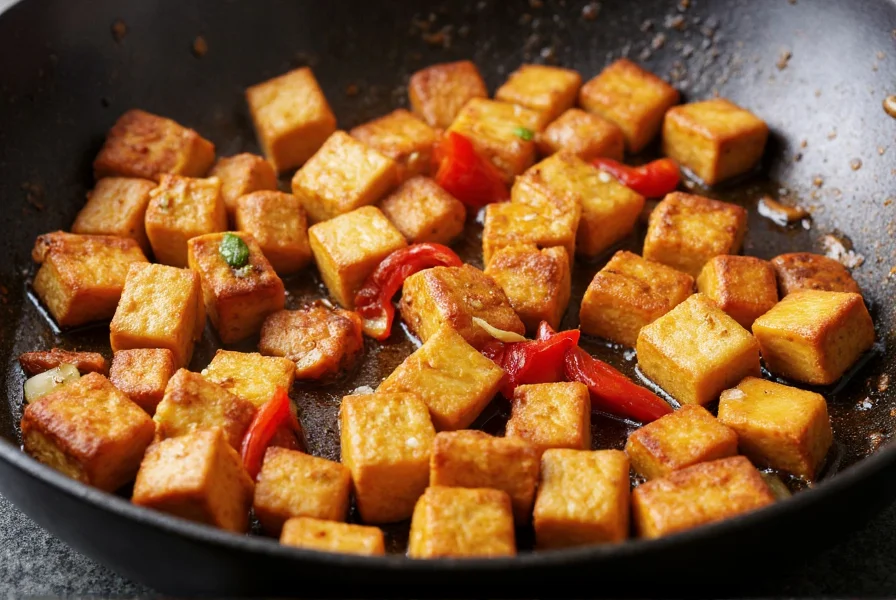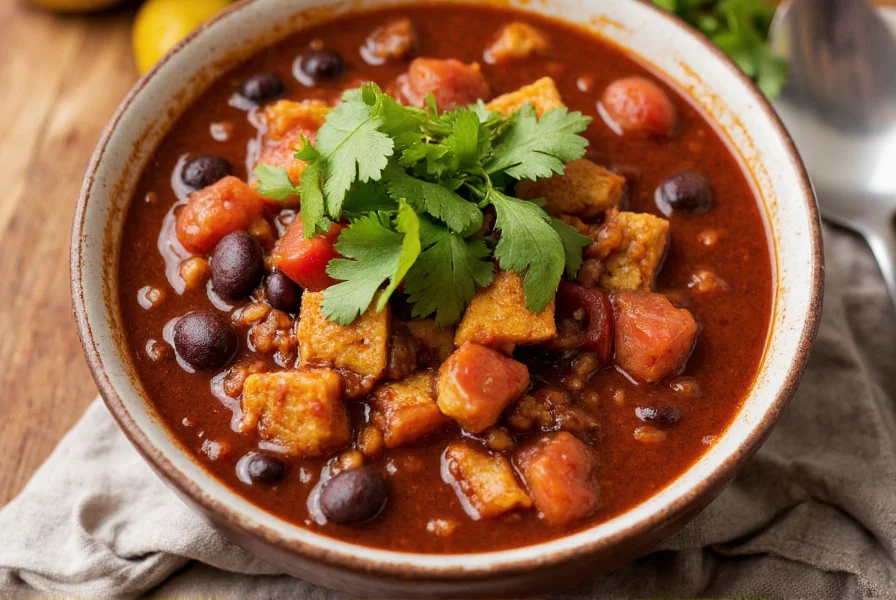Combining tofu and chili creates one of the most nutritionally balanced and flavor-packed plant-based meal options available today. This dynamic duo brings together the complete protein profile of soy-based tofu with the metabolism-boosting capsaicin found in chili peppers, resulting in dishes that satisfy both health-conscious eaters and flavor seekers. Whether you're exploring authentic Asian cuisine or developing innovative vegetarian recipes, understanding how to properly prepare and combine these ingredients elevates your cooking to professional levels.
The Nutritional Powerhouse Combination
Tofu provides approximately 10 grams of complete protein per 3.5-ounce serving, containing all nine essential amino acids that our bodies cannot produce. When paired with chili peppers, which contain capsaicin—the compound responsible for their heat—you create a meal that not only satisfies hunger but also offers significant health benefits. Research shows capsaicin may help reduce inflammation, improve heart health, and even support weight management through increased thermogenesis.
For those following plant-based diets, this combination delivers essential nutrients often challenging to obtain, including iron, calcium (especially in calcium-set tofu), and vitamin C from fresh chilies. The fiber content from both ingredients promotes digestive health while creating meals with impressive satiety factors—keeping you feeling full longer than many meat-based alternatives.
Cultural Significance Across Global Cuisines
Tofu and chili have been combined in culinary traditions worldwide for centuries. In Sichuan province of China, mapo tofu features soft tofu in a fiery chili and bean sauce that dates back to the late 19th century. Mexican cuisine incorporates tofu as a creative alternative in traditional chili dishes, while Indian cooking uses tofu (known as bean curd) in chili-based curries.
Understanding these cultural contexts helps home cooks appreciate the authentic preparation methods that maximize flavor. Traditional Sichuan cooking uses fermented chili bean paste (doubanjiang) rather than fresh chilies alone, creating complex umami notes that complement tofu's mild flavor. Meanwhile, Latin American approaches often involve roasting chilies first to develop deeper flavors before incorporating tofu as a protein substitute.
Selecting the Right Tofu for Chili Dishes
Not all tofu works equally well in chili applications. The water content and firmness dramatically affect how tofu absorbs flavors and maintains texture during cooking:
| Tofu Type | Water Content | Best For | Preparation Tip |
|---|---|---|---|
| Extra-Firm | Lowest (80-85%) | Stir-fries, grilled dishes | Press 15-30 minutes before use |
| Firm | Moderate (85-90%) | Chili recipes, stews | Freeze-thaw cycle for chewier texture |
| Soft | Higher (90-95%) | Soups, blended sauces | No pressing needed |
| Silken | Highest (95%+) | Creamy sauces, desserts | Use directly from package |
For most chili applications, firm or extra-firm tofu delivers the best results. Professional chefs recommend pressing firm tofu for at least 15 minutes to remove excess water, allowing it to better absorb marinades and spices. An advanced technique involves freezing tofu first, then thawing it—this creates a more porous, chewy texture that soaks up chili flavors exceptionally well.

Mastering Tofu Preparation for Optimal Chili Integration
Proper tofu preparation makes the difference between bland, watery results and restaurant-quality dishes. Start by selecting high-quality, organic tofu when possible, as it typically has a cleaner flavor profile. After pressing, consider these professional techniques:
- Dry-frying method: Heat a non-stick pan without oil and add pressed tofu cubes. Cook until golden brown on all sides before adding to chili—this creates a protective crust that prevents disintegration
- Marinating science: Use acidic components like lime juice or vinegar in marinades (15-30 minutes) to help tofu absorb flavors more effectively
- Layering technique: Add tofu during the last 10-15 minutes of cooking chili to maintain texture integrity while allowing flavor absorption
For authentic Sichuan tofu chili dishes, the secret lies in the mala (numbing-spicy) balance achieved through combining chili peppers with Sichuan peppercorns. This creates a distinctive tingling sensation that complements tofu's smooth texture. Start with a base of fermented black beans, ginger, and garlic, then add your prepared tofu toward the end of cooking.
Three Versatile Tofu Chili Recipe Frameworks
These adaptable frameworks work for weeknight dinners or special occasions, with options for varying heat levels and dietary preferences:
1. Quick Weeknight Tofu Chili Stir-fry
Ideal for beginners exploring healthy tofu chili recipes, this 20-minute dish uses accessible ingredients while delivering authentic flavors. Press and cube 14oz firm tofu, then dry-fry until golden. Remove tofu and sauté 2 minced garlic cloves and 1 tablespoon grated ginger. Add 2 chopped red chilies (seeds removed for milder heat), 1 sliced bell pepper, and 1 cup snap peas. Return tofu to pan with 3 tablespoons soy sauce, 1 tablespoon rice vinegar, and 1 teaspoon sesame oil. Cook 3-4 minutes until vegetables reach crisp-tender stage.
2. Hearty Vegetarian Chili with Tofu Crumbles
For those seeking substantial vegetarian chili with tofu, crumble extra-firm tofu to mimic ground meat texture. Press tofu thoroughly, then freeze overnight and thaw. Crumble with your hands and sauté with onions, garlic, and spices (2 tsp cumin, 1.5 tsp chili powder, 1 tsp smoked paprika) until browned. Add to traditional chili ingredients—beans, tomatoes, and broth—and simmer 30 minutes. The freeze-thaw process creates a meat-like texture that absorbs flavors exceptionally well.

3. Sichuan Mapo Tofu (Vegetarian Version)
This authentic tofu chili recipe traditionally contains meat, but a vegetarian adaptation remains deeply flavorful. Use soft tofu cut into 1-inch cubes. Heat 2 tbsp oil and add 2 tbsp fermented chili bean paste (doubanjiang), 1 tbsp Sichuan peppercorns (toasted and ground), and 2 minced garlic cloves. Add 1.5 cups vegetable broth and gently place tofu cubes into simmering sauce. Cook 5 minutes, then thicken with cornstarch slurry. Finish with scallions and additional Sichuan pepper for that signature mala experience.
Avoiding Common Tofu Chili Mistakes
Even experienced cooks make these errors when preparing tofu and chili dishes:
- Adding tofu too early: Causes disintegration in liquid-based chili recipes—always add during final cooking stages
- Insufficient pressing: Watery tofu won't absorb flavors properly—press at least 15 minutes for firm varieties
- Overlooking acid balance: Chili dishes need acid to brighten flavors—add lime juice or vinegar at the end
- Misjudging chili heat: Remove seeds and membranes from chilies for controlled spice levels
Professional chefs emphasize that patience with tofu preparation pays dividends in final dish quality. Taking time to properly press, marinate, and sear tofu creates textural contrast that elevates simple chili recipes into memorable meals. For meal prep enthusiasts, cooked tofu chili dishes often taste even better the next day as flavors continue to meld.
Frequently Asked Questions
Can I use silken tofu in chili recipes?
Silken tofu works best in blended chili sauces or soups where texture isn't critical, but doesn't hold up in traditional chili recipes. For chunky chili dishes, firm or extra-firm tofu provides the necessary structure. If using silken tofu, add it during the last 5 minutes of cooking to prevent disintegration.
How do I prevent tofu from falling apart in chili?
Press firm tofu for at least 15 minutes to remove excess water, then freeze and thaw it for a more resilient texture. Sear tofu cubes in a dry pan until golden before adding to chili, and incorporate them during the last 10-15 minutes of cooking. Using cornstarch coating before frying creates an additional protective layer.
What's the best chili pepper for tofu dishes?
Jalapeños offer moderate heat that complements tofu without overwhelming it, while serranos provide more intense spice for those who prefer hotter dishes. For authentic Sichuan flavor, use dried red chilies or fermented chili bean paste (doubanjiang). Remove seeds and membranes to control heat levels while maintaining chili flavor.
Does tofu absorb chili flavors effectively?
Yes, properly prepared tofu absorbs chili flavors remarkably well. Pressing removes competing water content, while marinating in acidic solutions (like vinegar or citrus-based marinades) for 15-30 minutes opens the tofu's structure to better absorb spices. Adding tofu during the final cooking stages allows it to take on flavors without breaking down.
Can I make tofu chili ahead of time?
Tofu chili often tastes better the next day as flavors continue to meld. Store components separately if possible—keep cooked tofu separate from sauce and combine when reheating. When storing together, use firm tofu which holds up better during reheating. Gently reheat on stove rather than microwave to preserve texture.











 浙公网安备
33010002000092号
浙公网安备
33010002000092号 浙B2-20120091-4
浙B2-20120091-4